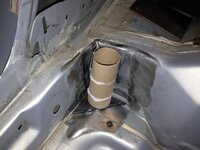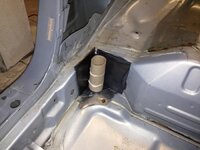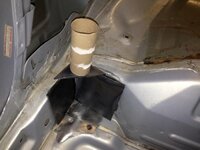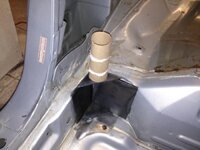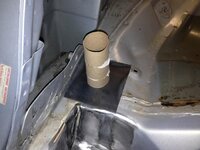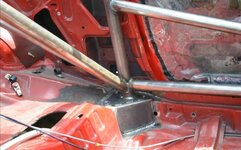Atuca
Supporting Member
- 1,140
- 292
- Jan 6, 2007
-
Central Valley,
California
I am surprised I haven't seen more "how tos" or "walk throughs" on how to build a roll cage, perhaps because of the extreme amount of attention to detail required to build one, especially one the passes all the safety requirements to be NASA and SCCA compliant.
I have never built a roll cage before, but that doesn't mean I don't want to do it myself. Since I have many more questions than answers I will keep this seperate from my build thread, but what information that is relevant in my case:
The car weighs ~2700 lbs (more likely less, but this is a grosely over estimated safe number) making it compliant with both NASA and SCCA using 1.50 x .120 DOM tubing in all classes I may want to race in.
NASA Page 46 CCR:
SCCA Page 145 GCR:
The base plates are being contructed out of 1/8" steel, a bit thicker then the minimum required at 0.080" thick.
The rest of the requirements for bends or ect I believe I have a full understanding of, but for those perhaps new to a Road Race roll cage and the rules, you can read them here:
Nasa:
http://www.nasaproracing.com/rules/ccr.pdf
SCCA:
http://sports.racer.net/docs/rules/2002/sect_18_roll_cage_and_chassis_2002_gcr.pdf
Now, I plan to do Time Trials with my purpose built race car. I'd tune the car's power to be eligable for TT1 NASA, and perhaps lower then that while I work my way through NASA HPDE. I need to build the cage now even before I finish HPDE for the following reasons:
1) Safety on the track with all the other n00bs on the track with me learning to not be so nuts (me included!)
2) Cut off switch mounting - as it has to be reachable by both me while buckled in and crew workers outside the car, the common place is the A piller / Halo support bar of the roll cage
3) Harness mounts for a proper 6/5 point belt and race seat
4) I need to make a structural rear wing mount, and this may or may not tie directly into my cage. The wing is part of a full vehicle aero package I am running and it is not an option to NOT have a structural mount. What is an option is wether or not it is tied into the cage like Beau did, or I might do some aluminum mounts, I'm thinking about this as part of the design but havn't made any decisions yet.
I want to design a 6 point roll cage to start; I can always later go through the firewall from my halo support bars if I choose to later, or if I decide before I am done welding the 6 point
I purchased my tube bender from here: https://www.jd2.com/p-32-model-3-bender.aspx
I also got a die for my 1.5 inch tubing that had no more then 3 times the bend radius, putting it at 4.5".
I am using a Lincoln Pro Mig 140, and got a new 11lb spool and a fresh tank of gas.
I purchased 5 24' bars of DOM tubing (120 feet total), and 1 20' of 6" x 1/8" steel plate. I should have some left over but that is just extra insurance.
Now to begin the cage building! The logical place to start to me was the main hoop... and I already have questions!
I have a few options, ranging from drilling a hole and just using a single base plate, to a stronger (imo) mounting platform, so variations on placement. I would like opinions please!
(toilet paper roll not to DOM tubing scale )
)
Option 1 would be a small base plate, where I would first drill a hole under so I could drop the cage later for final welding after everything is tacked into place.
Option 2 would be the same as Option 1 above, except I would also weld the vertical supports to the base plate because I believe the side of the car there to be the frame rail, and the back there seems to also be a horizontal support beam thicker in metal then elsewhere in the car.
Option 3 would have me building a base plate mounted up ~4 inches. I would enclose this triangle with no metal on the bottom, using just the 3 vertical plates and the top.
Option 4 would be the same as the above Option 3, enclosed on all 3 sides with the addition of the bottom plate.
Option 5 came to light more recently as an option. I would NOT drill a hold through what I think is the frame rail. I would be able to get to the top of the cage by building the front cage base plates a few inches in the air and just tipping the cage forward when its time to weld everything permantely. The problem I have with this option is the metal in this spot starts to rise and I fear the frame rail metal does not rise since I can see it inside the b pillar continuing parallel to the ground. The makes me think it is not the strongest place to put it, and maybe as an option 6 I would have metal vertically as in Option 3 and 4, but the top of the place be like here in Option 5. However... with all of this said in Option 5, I saw done on a GT Fabrication 2g Roll cage and I assume is fine, viewed here:
another example of this kind of Option 6 and 3/4 together I saw here:
Option 7, To be honest, is what I really like. It looks like it would be just be two pieces of metal, much larger then the small box I was considering. It looks to be sitting on top of the side frame rail as well as the horrizontal thicker metal where the rear seat used to be.
I would love if I could get a little feedback on what option you would choose, or pictures on what you guys decided for final placement of a road race main hoop in your car. Since I don't know everything, I dont know exactly how I would weld the base plates if I made a fully enclosed "box", or if that is even what you do. I would love some pointers! Then I will document the steps I take for anyone else in the future on my build journal and here so they have somewhere on dsmtuners to see a cage being built and some of the reasons I do what I do. I never claimed to know everything about building roll cages, but I feel confident I will be able to build a cage safely and able to pass tech with a little homework.
I have never built a roll cage before, but that doesn't mean I don't want to do it myself. Since I have many more questions than answers I will keep this seperate from my build thread, but what information that is relevant in my case:
The car weighs ~2700 lbs (more likely less, but this is a grosely over estimated safe number) making it compliant with both NASA and SCCA using 1.50 x .120 DOM tubing in all classes I may want to race in.
NASA Page 46 CCR:
2501 - 3000 lbs
1.500 x 0.120 Seamless Alloy (4130), Seamless mild steel (CDS Mechanical) or DOM
SCCA Page 145 GCR:
Over 2500 lbs. 1.50 x .120 Mild Steel
2201-3000 lbs 1.500 x .120 DOM
The base plates are being contructed out of 1/8" steel, a bit thicker then the minimum required at 0.080" thick.
NASA CCR:
15.6.14 Mounting Plates
Each mounting plate shall be no greater than one hundred (100) square inches, and no less than nine (9)
square inches. Each mounting plate must be no greater than twelve (12) inches or less than two (2) inches on
any side. Welded mounting plates shall be at least 0.080-inch thick. Plates may extend onto vertical sections
of the structure. Any mounting plate may be multi-angled, but shall not exceed one hundred (100) square
inches total including vertical sections.
The rest of the requirements for bends or ect I believe I have a full understanding of, but for those perhaps new to a Road Race roll cage and the rules, you can read them here:
Nasa:
http://www.nasaproracing.com/rules/ccr.pdf
SCCA:
http://sports.racer.net/docs/rules/2002/sect_18_roll_cage_and_chassis_2002_gcr.pdf
Now, I plan to do Time Trials with my purpose built race car. I'd tune the car's power to be eligable for TT1 NASA, and perhaps lower then that while I work my way through NASA HPDE. I need to build the cage now even before I finish HPDE for the following reasons:
1) Safety on the track with all the other n00bs on the track with me learning to not be so nuts (me included!)
2) Cut off switch mounting - as it has to be reachable by both me while buckled in and crew workers outside the car, the common place is the A piller / Halo support bar of the roll cage
3) Harness mounts for a proper 6/5 point belt and race seat
4) I need to make a structural rear wing mount, and this may or may not tie directly into my cage. The wing is part of a full vehicle aero package I am running and it is not an option to NOT have a structural mount. What is an option is wether or not it is tied into the cage like Beau did, or I might do some aluminum mounts, I'm thinking about this as part of the design but havn't made any decisions yet.
You must be logged in to view this image or video.
I want to design a 6 point roll cage to start; I can always later go through the firewall from my halo support bars if I choose to later, or if I decide before I am done welding the 6 point

I purchased my tube bender from here: https://www.jd2.com/p-32-model-3-bender.aspx
I also got a die for my 1.5 inch tubing that had no more then 3 times the bend radius, putting it at 4.5".
I am using a Lincoln Pro Mig 140, and got a new 11lb spool and a fresh tank of gas.
I purchased 5 24' bars of DOM tubing (120 feet total), and 1 20' of 6" x 1/8" steel plate. I should have some left over but that is just extra insurance.
Now to begin the cage building! The logical place to start to me was the main hoop... and I already have questions!

I have a few options, ranging from drilling a hole and just using a single base plate, to a stronger (imo) mounting platform, so variations on placement. I would like opinions please!
(toilet paper roll not to DOM tubing scale
 )
)
You must be logged in to view this image or video.
Option 1 would be a small base plate, where I would first drill a hole under so I could drop the cage later for final welding after everything is tacked into place.
You must be logged in to view this image or video.
Option 2 would be the same as Option 1 above, except I would also weld the vertical supports to the base plate because I believe the side of the car there to be the frame rail, and the back there seems to also be a horizontal support beam thicker in metal then elsewhere in the car.
You must be logged in to view this image or video.
Option 3 would have me building a base plate mounted up ~4 inches. I would enclose this triangle with no metal on the bottom, using just the 3 vertical plates and the top.
You must be logged in to view this image or video.
Option 4 would be the same as the above Option 3, enclosed on all 3 sides with the addition of the bottom plate.
You must be logged in to view this image or video.
Option 5 came to light more recently as an option. I would NOT drill a hold through what I think is the frame rail. I would be able to get to the top of the cage by building the front cage base plates a few inches in the air and just tipping the cage forward when its time to weld everything permantely. The problem I have with this option is the metal in this spot starts to rise and I fear the frame rail metal does not rise since I can see it inside the b pillar continuing parallel to the ground. The makes me think it is not the strongest place to put it, and maybe as an option 6 I would have metal vertically as in Option 3 and 4, but the top of the place be like here in Option 5. However... with all of this said in Option 5, I saw done on a GT Fabrication 2g Roll cage and I assume is fine, viewed here:
You must be logged in to view this image or video.
another example of this kind of Option 6 and 3/4 together I saw here:
You must be logged in to view this image or video.
Option 7, To be honest, is what I really like. It looks like it would be just be two pieces of metal, much larger then the small box I was considering. It looks to be sitting on top of the side frame rail as well as the horrizontal thicker metal where the rear seat used to be.
I would love if I could get a little feedback on what option you would choose, or pictures on what you guys decided for final placement of a road race main hoop in your car. Since I don't know everything, I dont know exactly how I would weld the base plates if I made a fully enclosed "box", or if that is even what you do. I would love some pointers! Then I will document the steps I take for anyone else in the future on my build journal and here so they have somewhere on dsmtuners to see a cage being built and some of the reasons I do what I do. I never claimed to know everything about building roll cages, but I feel confident I will be able to build a cage safely and able to pass tech with a little homework.



